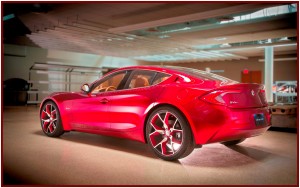
Fisker has a range problem, similar to EVS. Can it reach its stated goal of creating 2,000 autoworker jobs by building 100,000 plug-in hybrids per year in Delaware before it runs out of cash?
Fisker Automotive showed an all-new model, the Atlantic sedan at an event ahead of the New York Auto Show. The four-door prototype is a plug-in series hybrid that will be priced, it’s said, starting around $50,000, if the loss making start-up company ever gets the funding needed to refurbish and tool a former General Motors plant to build it.
Fisker, of course, was the recipient of a controversial taxpayer-subsidized $529 million loan from the Department of Energy in 2010 as part of an abortive federal government effort to prod development of so-called advanced-technology vehicles and create jobs. Part of the loan was for using a closed General Motors plant in Wilmington, Delaware – the home state of vice president Joe Biden – to build the small compact car, then code named Nina. Fisker said that about one-third of the total loan amount – $190 million – was used mostly for Fisker Karma, which is now in production in Finland.
Ultimately, Fisker was unable to meet the deadlines imposed by DOE and the rest of the loan was put on hold last May. This was after the DOE program came under attack because of the collapse of solar panel maker Solyndra and the demonstrably dubious prospects of other loans and loan applicants under an Obama Administration stimulus package.
Fisker, which has never earned a profit since its 2007 inception, says it is now pursuing both private equity and the resumption of government financing. However, the private money raised thus far is apparently not enough to keep the company building the $108,000 Karma EV in Finland (hardly U.S. job creation there) and invest in the Atlantic, aka Nina.
In essence, Fisker has a range problem similar to EVS. There are serious doubts about whether it can reach its stated destination of creating 2,000 autoworker jobs by building 100,000 plug-in hybrids per year at the 3.2 million square-foot factory in Delaware before it runs out of cash.
Atlantic is typical of current plug-in hybrids with its four-cylinder gasoline engine acting as a generator, although it is not mechanically connected to the wheels – the same design as the Chevrolet Volt, which at current rates will sell fewer than 30,000 units in 2012.
At the end of March, A123 Systems (Nasdaq: AONE), a taxpayer-subsidized developer and manufacturer of advanced lithium iron phosphate batteries, said it was recalling battery modules and packs that may contain defective cells produced at A123’s Livonia, Mich. plant.
The estimated $55 million – best guess – recall comes after the well-publicized failure during testing of a Fisker Karma that was owned by Consumer Reports. A123, an investor in Fisker as well as ac supplier, lost almost $260 million in 2011.
A123 received a $249.1 million grant from the Department of Energy to reopen plants in Livonia and Romulus, Mich., as well as money and tax credits from Michigan worth more than $100 million. The future of A123, which has never earned a profit, along with Fisker is not clear.
See:
- A123 Recalls Lithium Ion Batteries Shipped to Fisker, Others
- DOE Nixes Carbon Motors Loan in Taxpayer Subsidy Storm
- Fisker Automotive Makes Tom LaSorda CEO

